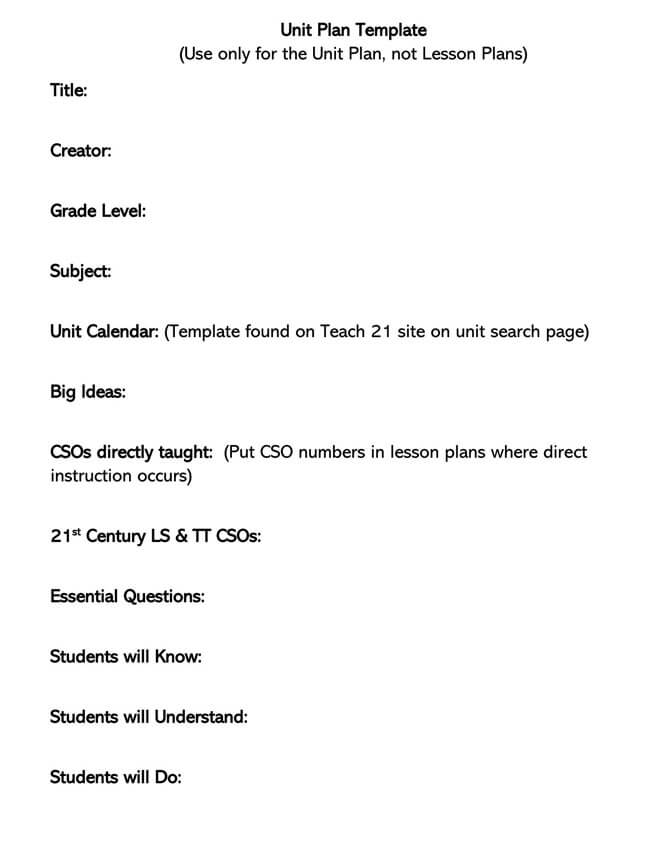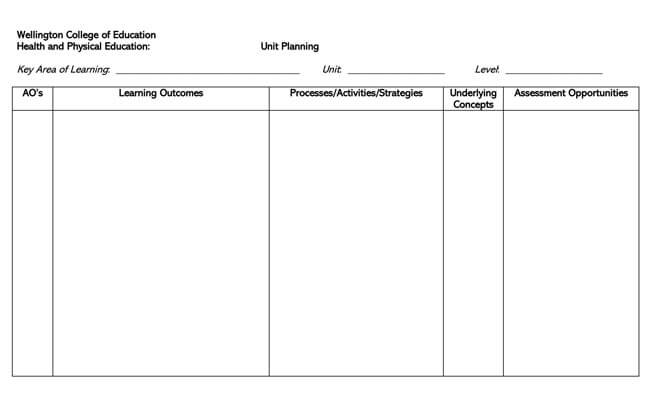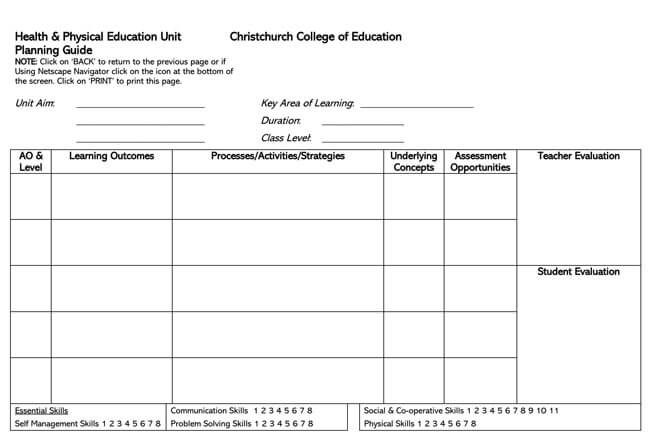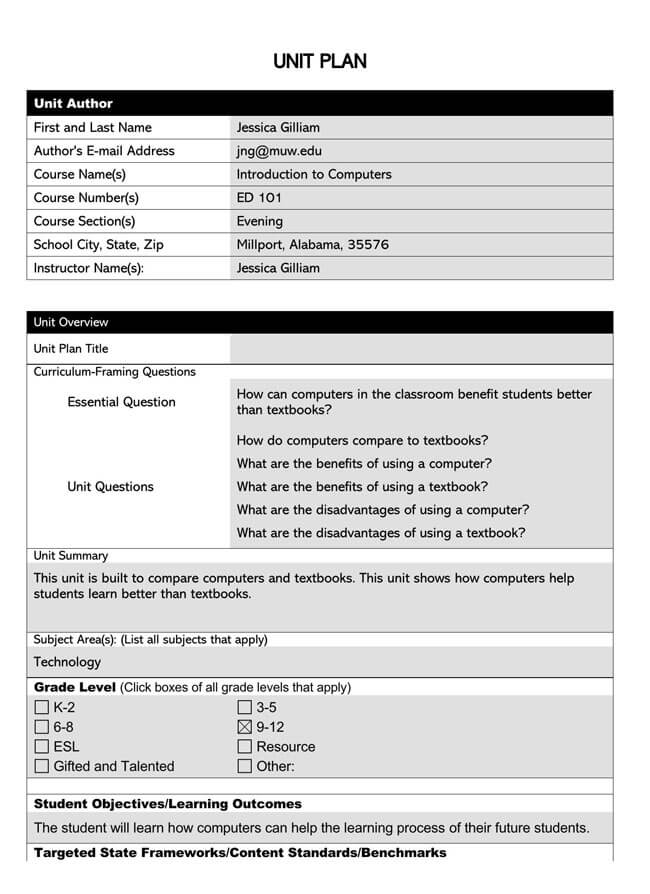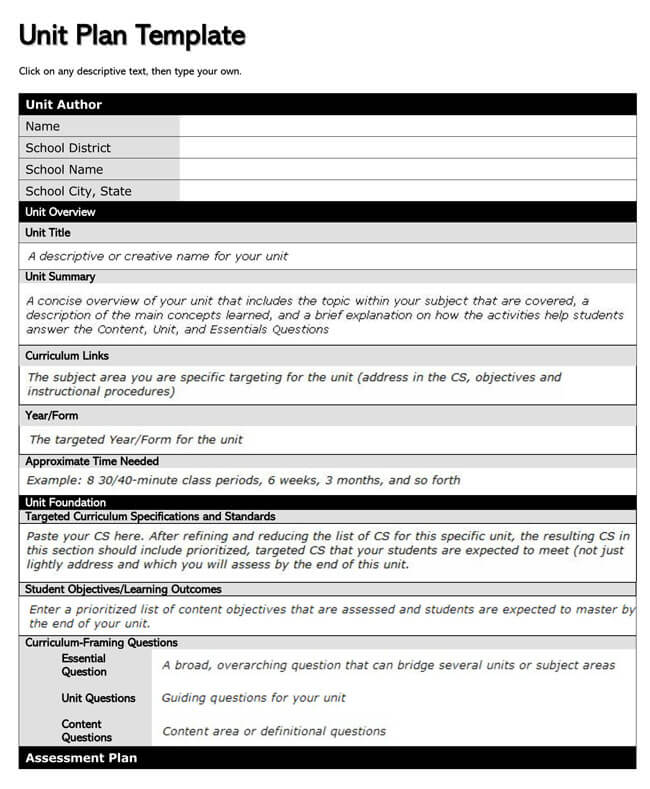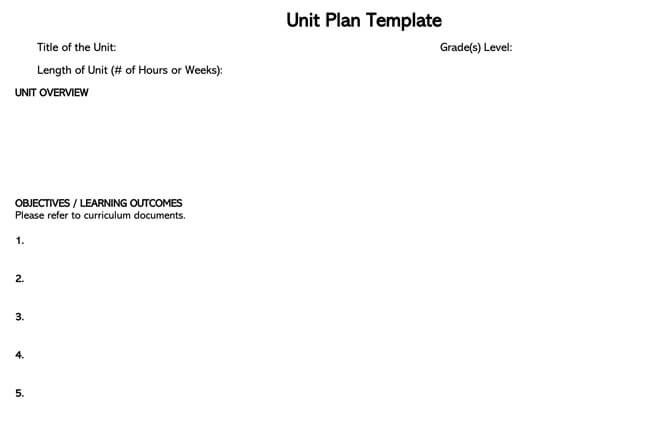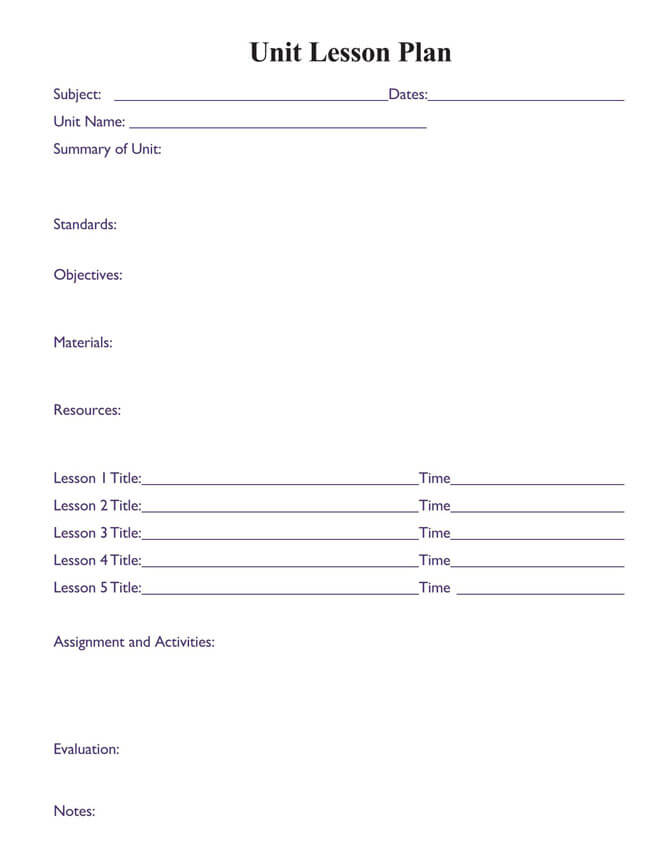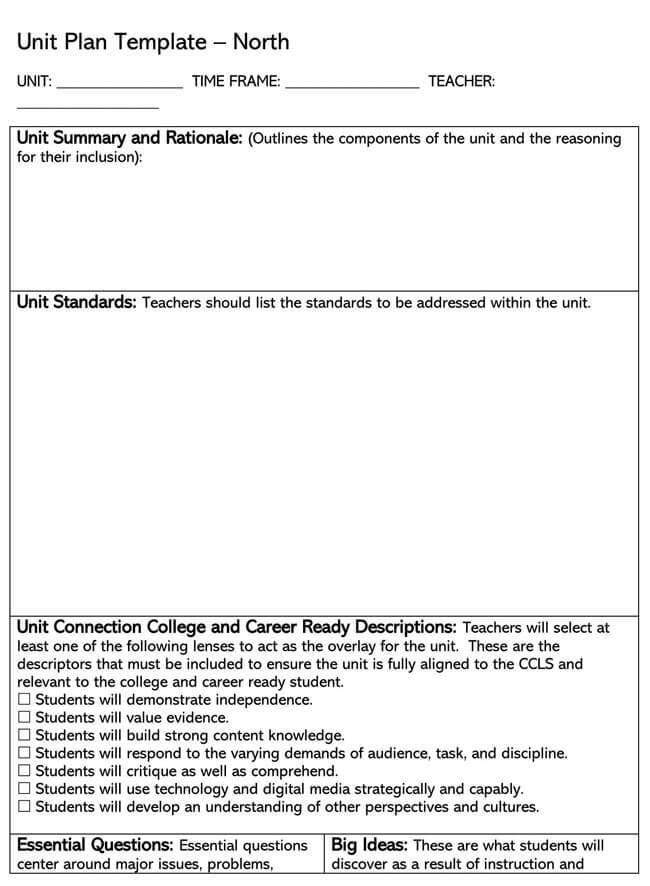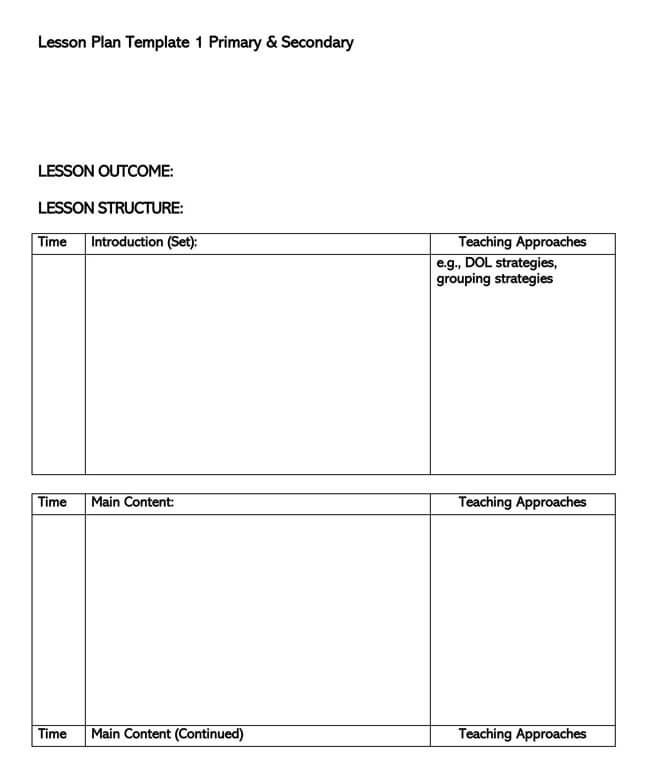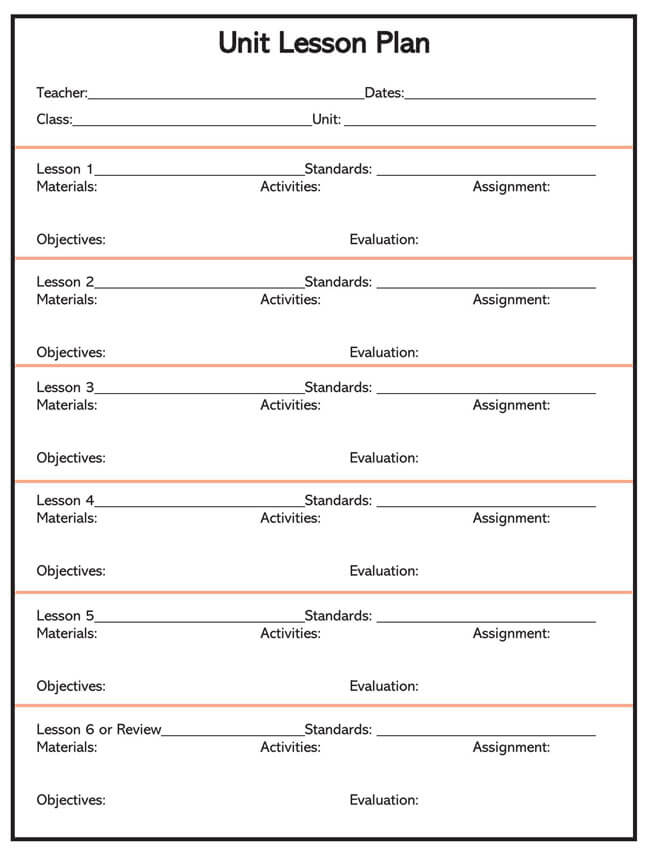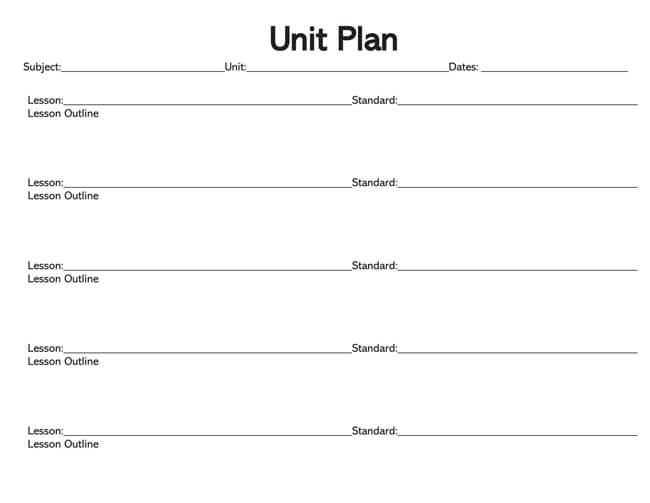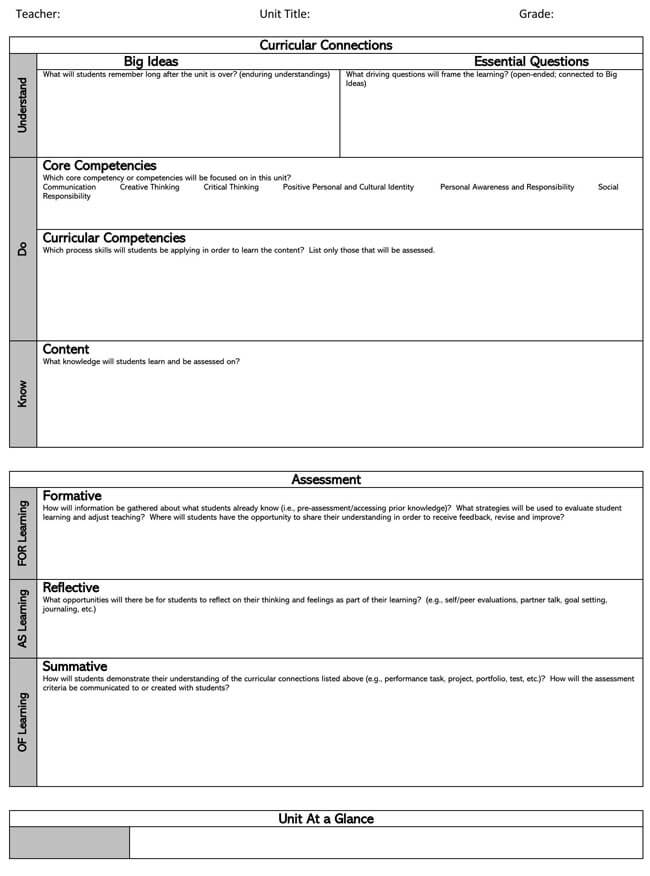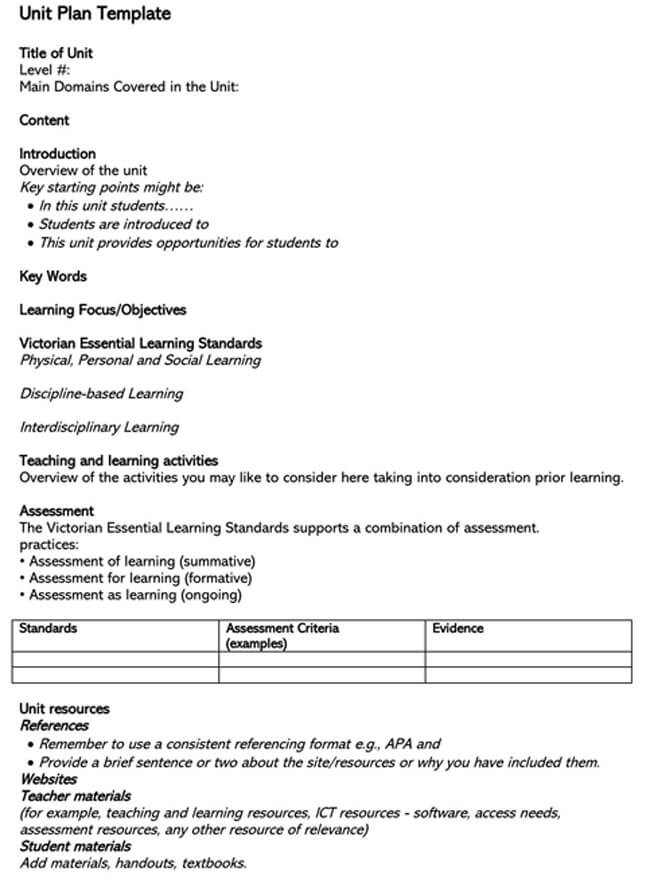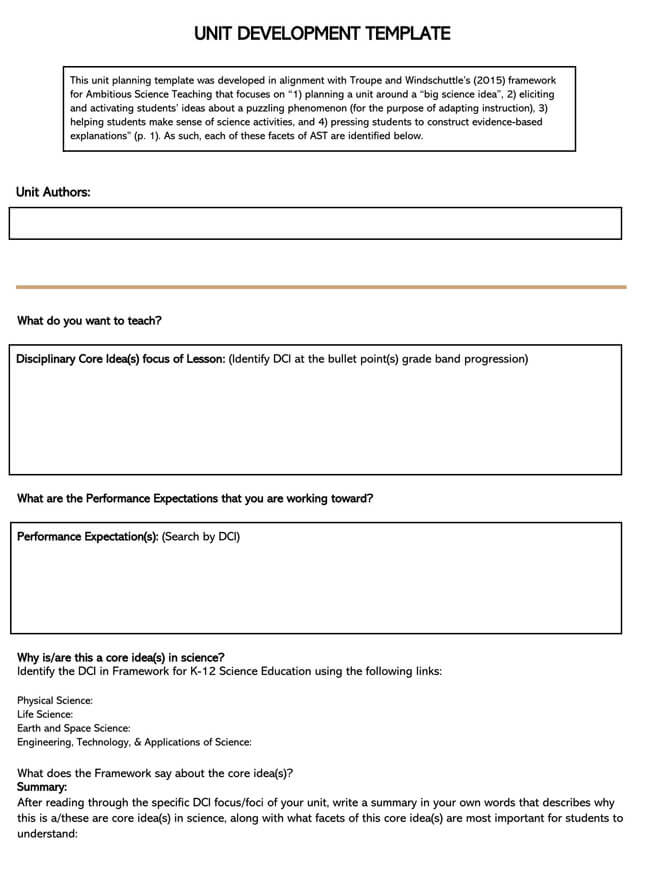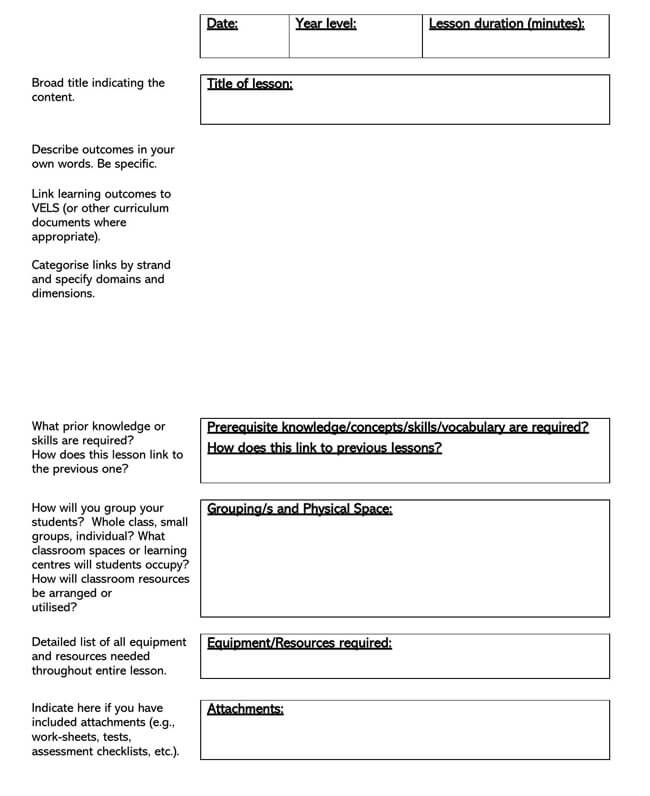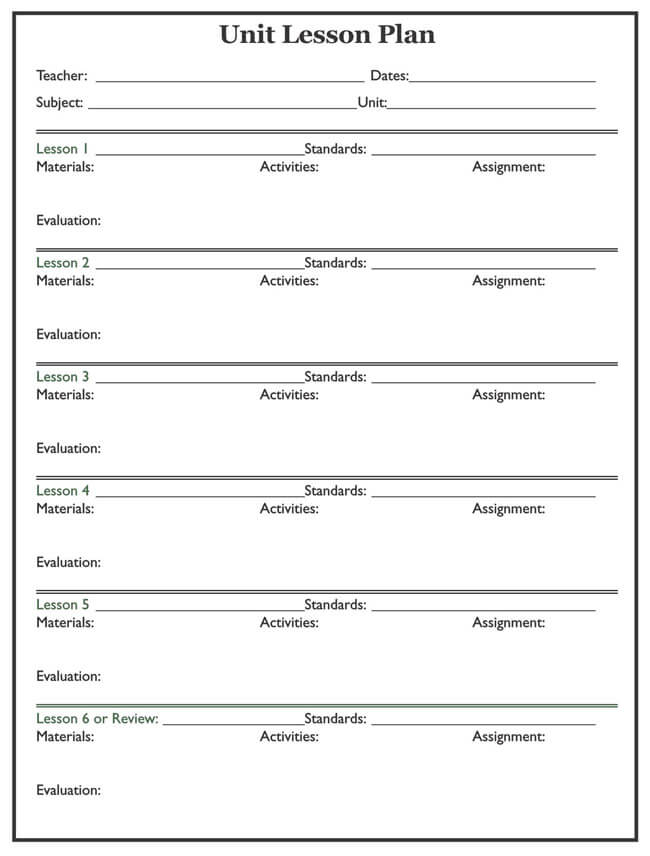As a teacher, a unit plan is something that makes your job more coordinated especially if it has been provided by the district.
By definition,
It is a teacher’s detailed description of the course material or learning plan for a lesson.
This plan is developed to guide the daily class learning. However, not all districts provide their teachers with this plan, and if you find yourself in such a district, you merely need to create your own.
Free Templates
General Elements of Unit Plan
Your plan must include certain elements that are relevant to the quality, direction, and pace of your lessons. It is essential that it include the important elements that make this plan comprehensive and detailed enough to cover all essential aspects of your syllabus and lessons.
Here are the elements you must include in your plan:
- General practices-This is the daily routine incorporated into the lesson. It sets a standard for the general proceeding of the class.
- Mathematical standards-The varieties of expertise that mathematics teachers should seek to develop in students.
- Scope and sequence of the per-day lessons-A list of concepts, materials, and topics that are covered in a book, lesson plan, or course of a particular curriculum.
- Teaching strategies and models-Instructional strategy teachers use to demonstrate a new concept or approach to students learning by observing.
- Assessments to be taught-Provide feedback on how well the students learn the unit.
This plan is meant to provide direction and depth to your lesson and lesson plans. Typically, it has several advantages apart from the obvious advantage of providing a structured framework for your lessons. Using this plan in your teaching ensures that your lessons adhere to the set guidelines of your profession.
Having a preset unit plan leaves you with plenty of time to work on the main content of your lesson. You will be able to focus on providing content that checks the pre-set boxes and meets universal teaching standards. With this, your lessons can have a proper direction and follow pre-set instructions as you deliver your lesson. You can also easily set milestones and reasonable deadlines for all your lessons.
remember
Using a this plan provides a varied approach to teaching activities and strategies.
Education is not meant to be delivered using a singular approach. Teaching strategies may be varied as well as the teaching activities.
Also, setting your lessons according to this plan encourages you to follow all recommended standards in delivering your lessons. By following this plan, you will not leave out or forget any standard as you deliver your lesson. Moreover, the content is the heart of the lesson, and with this plan, the content of the lesson will follow a definite direction, adhering to all relevant standards. The Content would be concise and direct, achieving the goals for which it was created.
The assessments are used to gauge the efficacy of lessons delivered. Using this plan creates a clear direction for assessments to be administered. It provides the ideal time for the assessments and the extent to which the assessments would be administered.
Pre-Writing Elements of Consideration
Before writing your unit plan, it is important that you identify the important elements that must be included in it.
Here are the elements that make an ideal plan:
- Pinpoint your goal according to state standards-The first thing that you need to do is to pinpoint your goals according to state standards. What are the goals the state requires you to achieve in your lesson? Once you have identified these goals, you may set your goals according to the standard of your state.
- Analyze where the gap exists –In any educational setting, there are often gaps and these gaps exist in sensitive places. It is a wise choice that you identify and analyze where the gaps exist and how you can close them.
- Make notes for difficult lessons –All lessons are not the same. Some are easier than others. It is advisable that you identify the difficult lessons and make notes for them. Try to simplify them to make it easier.
- Know about student’s needs and learning styles –As a teacher, it is important that you familiarize yourself with the needs of the student and their learning styles. No two students have the same learning styles, and it is important that you tailor your lesson to the students’ needs and learning styles.
Making a Unit Plan
The basic aim of this plan is to ensure that your lesson plans link each lesson to the next. It is therefore important that you take certain calculated steps to ensure the quality of your unit plan.
Understanding is the key
The aim of this plan is to provide a structured guide that simplifies the teacher’s instructions in a well-structured and well-planned manner.
A well-structured unit plan will facilitate understanding in the following ways:
- Keep the lesson goals and key concepts side by side: When making this plan, you need to support key concepts and learning goals with a carefully mapped structure. This plan should help you to weave learning goals and key concepts together over time, and between or among disciplines.
- Provide longer time for self-study and practices: Your unit plan should focus on allowing for longer periods for self-study practices. You can do this by overlapping lessons with other teachers to make long periods of time available for practice and study.
- Plan for a longer period: This plan is a comprehensive standard by which you plan and strategize your lessons. Making this plan should be a thorough and thoughtful process. It is important that you plan your lessons well, and you need to set aside enough time for this.
- Unit Plans help in clear guidance: By planning your lessons according to a comprehensive plan, you can provide clear guidance and instruction in all your lessons, improving your efficiency significantly.
Planning for short-term lessons
Short-term lessons, like any other lesson, require a well-structured plan as well as a detailed outline. It is essential to take calculated steps when planning for a short lesson.
For the best results, consider the tips below:
Identify your goal first
The first step to planning for a short-term lesson is to identify the goal of the lesson. You need to analyze what the key content is going to be, as well as the skills and vocabulary with which this content will be delivered. Set a goal of what the students need to learn at the end of the course.
Mention the ways and methods
Once you have identified the goal of the lesson, the method should follow. Mentioning the methods and ways allows you to choose the most effective method to deliver your lesson. Here it is advisable to go by track record, only select methods that have been proven to be the most effective.
Develop a set of questions
For every lesson, there are a set of questions that should be answered at the end of the lesson. These questions are the core content of the lesson, and the best way to make a unit plan for your lesson is to develop the relevant set of questions to be answered by your lesson. Your lesson should provide answers to these core questions.
Survey your resources thoroughly
Your resources will provide the content of your lesson. Your lesson reflects the quality of your resources as much as your skills. It is essential that you effectively analyze your resources and extract important information to build your lesson.
State laws and standards
Each state has its own laws and standards for its teachers. This step is especially important if you are a new teacher or you just started working in a new state. If you familiarize yourself with the state laws governing your state, you would be able to set the acceptable standards in your unit plans and plan your lessons accordingly.
Mention major to minor goals
Your unit plans to guide your lessons according to set standards. These standards provide you with a clear direction for your lessons. It is important that you identify the major and minor goals of your lessons. Your goals, both major and minor, influence the direction and content of your lessons.
Mention a time-span for each goal
A goal is merely a wish until you put a deadline on it. When making a unit plan, your goals, no matter how minor, should have a time stamp attached to them. This provides motivation to achieve these goals in your lessons.
Plan the assessments
As with your lessons, assessments are an essential aspect of each lesson. As such, assessments must be properly planned to enable the teacher to get a good idea of the effectiveness of their lessons. You can evaluate learning by using both formative and summative assessments. An assessment provides a broad evaluation of the objectives and how well the students meet them.
- Formative assessment: A formative assessment monitors students’ learning and provides ongoing feedback. These assessment tools help the teacher understand how well the students are learning the course material. It allows you to adjust as your lessons progress. Formative assessments typically have very little, if any point value. Formative assessments are only meant as a check for you, and not as an assessment of student performance.
- Summative assessment: Summative assessments on the other hand evaluate student learning, typically at the end of each instructional unit. Summative assessments have high point values and are used to gauge student performance.
Plan and create your assessment tools
Determine what assessment tools you would like to use and create them with a schedule in place. You should use both the formative assessment, to gauge the effectiveness of your lessons, and the summative assessments to gauge student performance.
- Have benchmarks in place: Once you start the unit, you need to put benchmarks in place to help you maneuver through the unit. Having benchmarks will help you stay on track, on time and ensure that the students meet the learning objectives. Formative benchmarks can provide useful benchmarks too, allowing you to gauge your performance.
- Plan points too: It is better to plan points at which you will move on to new material regardless of student understanding. Spending too much time on one segment of your lesson will affect the available time for other segments of your lesson.
Methods for interdisciplinary units
Interdisciplinary units have the greatest benefit of broadening the scope of the lesson to meet the needs of the student. If you plan, you can put in place a structure that gives students the opportunity to view broad concepts from many different angles.
However, it is important that you take the following steps to ensure that the interdisciplinary unit is as effective as it should be:
Find competent partners
An effective interdisciplinary relationship involves two or more teachers with the zeal to work together to meet students’ needs. You must ensure that you partner with colleagues that are ready to contribute similarly to the overall unit planning workload.
Think creatively
You need to find a common ground between both disciplines and think of a creative approach to your lesson. If, for instance, you are a language arts instructor, a collaboration with the history teacher will help deliver a lesson in the history of the civil war as students are taught using The Red Badge of Courage.
Be sure to coordinate assessment tools as well as lesson plans as you need to be in communication with the other instructor to determine the effectiveness of your instructions.
Confirm the assessment tools
As you collaborate with your colleagues across disciplines, you need to routinely confirm your assessment tools to determine how efficient your collaboration is and the impact it has on students’ learning. Also, confirm your lesson plans to ensure that you are on schedule and on track.
Same lesson-different angles
Interdisciplinary collaboration provides a different approach to a typical lesson. However, there are other angles from which you can approach the subject matter. Try approaching the lesson from multiple angles to see which one would be more effective.
Must Do’s
In writing a unit plan, you are required to check a few boxes. A standard unit plan has some set requirements that you need to follow.
Here are some things you must do when making this plan:
- You must have resources for the activities: Before you begin to plan your lessons, be sure that you have all the resources required for the activities involved in each lesson.
- You must stick to the timeline: Your entire timeframe for delivering the unit plan lessons is a rigid one, and as such, your small deadlines, and how you meet them influence your total coverage in the ng run. If you have assigned a timeline for the completion of a unit. You must stick to it and move on to other units to avoid sacrificing other units for a single unit.
- You must be aware of the teaching standards: Every institution and state have a standard to which all teachers must adhere. It is impossible to adhere to a teaching standard that you are unaware of. Therefore, it is important to be cognizant of the teaching standards to which you must adhere as well as all relevant subject matter standards.
Professional Key Points
Creating a unit plan requires careful planning and close attention to detail.
Here are some tips to help you make a concise plan:
Lists of resources
Be sure to gather a list of the resources used to write your unit plan. You may add to this list every time you present the plan. Your resources do not necessarily have to be books or internet sources, you may also talk to people who have created these plans in the past, or people who may be experts in the field of study in which you want to create this plan.
pro tip
Over-plan is a lifesaver.
You may be apprehensive about planning more activities than necessary in your unit plan; however, it is much better to plan more activities than not planning enough activities in your plan. So go ahead and over plan.
People-the best resource
The best source for comprehensive and proven content is people. The people around you, your more experienced colleagues, experts in the field in which you are making a lesson plan, and generally anyone with the relevant information is a better source than any book you may find.
Know how to prioritize
While delivering the lessons, one must know how to deliver the lesson while maintaining the time too. For this, one must prioritize concepts over supplementary supporting material that can be sacrificed if necessary.
Use variety in lessons
Let your students experience your lessons through various means. As mentioned above, no two students are the same, and as such, there should be more than one approach to delivering your lesson. Allowing students to experience the unit of study from a different perspective ensures that more students learn effectively.
Frequently Asked Questions
A lesson plan elaborates on the objectives of a particular lesson, and how the teacher plans to achieve those objectives while the unit plan covers a wider area. A unit plan often includes many lessons.
A unit plan consists of concepts and learning goals which are to be taught over a period and woven together across a subject area. Typically, a unit plan may last two to three weeks.
It all depends on the individual making the unit plan and the nature of the content of the plan, how elaborate the plan would be, and if there would be a need for interdisciplinary collaboration.
Final Words
A unit plan is a great way to provide guidance and direction in your lessons. It encourages you to set deadlines and goals in your lessons. It is therefore ideal that you plan your lessons according to a comprehensive plan. You can download a quality comprehensive template here.
